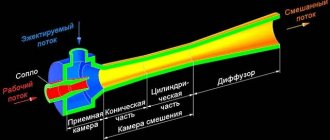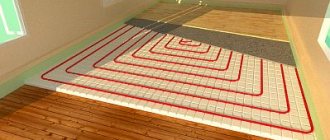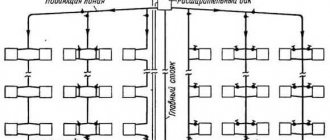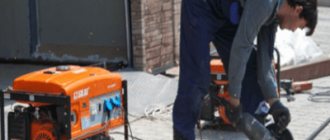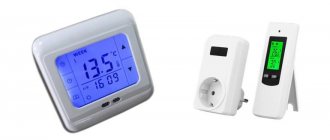Heating control methods
Thermostat for the battery
When the coolant is heated, it expands and, as a result, increases in volume. Therefore, before adjusting the heating radiators in the apartment, you need to ensure general control of the operation of the system.
Several types of devices are designed for this. They are conventionally divided into regulating and controlling. The first ones are designed to change the current characteristics of the system (pressure and temperature) towards decreasing or increasing. They are installed on a specific section of the pipeline or for the entire system as a whole. Control devices include pressure gauges and thermometers, mounted together with control devices or separately.
How to adjust the pressure in the heating system when operating a solid fuel and gas boiler? To do this, you need to be guided by the following principles for designing control systems:
- Installation of pressure gauges (thermometers) before and after the boiler, in distribution manifolds in the highest and lowest parts of the system;
- If there is a circulation pump, the pressure gauge is installed before it;
- Mandatory installation of an expansion tank. In closed systems it can be of the membrane type, in open systems it can be leaky;
- The safety valve and air vent will prevent critical excess pressure in the pipes.
The average water temperature in the pipes should not exceed 90 degrees. The pressure should be in the range from 1.5 to 3 atm. It is possible to make a system with parameters exceeding the specified ones, but in this case you will need to select special components.
If you cannot adjust the heating radiators in your apartment using a thermostat, there is most likely an air lock. To eliminate it, a Mayevsky crane is needed.
Regulating the heating of a private house
Autonomous heating scheme
For owners of private houses, a pressing question is: how to adjust a two-pipe heating system. Unlike central heating, the parameters of autonomous heating are influenced only by internal factors.
The main ones are the design of the boiler, the types of fuel used and its thermal power. Also, the ability to adjust coolant parameters directly depends on the following system indicators:
- Diameter and material of pipes . The larger the cross-section of the line, the faster the water will expand as a result of rising temperature;
- Characteristics of radiators . Before adjusting the heating radiator, it is necessary to make its correct connection to the pipeline. In the future, using special devices, you can reduce or increase the speed and volume of coolant passing through the heating device;
- Possibility of installing mixing units . They can be installed for a two-pipe heating system and with their help the water temperature is reduced by mixing hot and cold flows.
In order to find out how to adjust the heating system in a private home, it is recommended to consider all possible options.
The installation of pressure control mechanisms in the heating system must be provided for at the design stage. Otherwise, even a small error during installation can lead to loss of efficiency of the entire system.
Wiring of simple heating systems
A heating system can be called simple if it contains one direct circuit. A direct circuit means a line into which coolant is supplied from the boiler without changing the initial temperature. Some radiator heating systems are simple. They can be single-pipe, double-pipe or mixed. The most practical type of simple radiator heating is a two-pipe system based on a supply and return line.
And if its balancing is done correctly, such a system will ensure uniform heating of the radiators along the entire heating perimeter.
Let's consider the main elements of the system and their functions.
Stabilization of pressure in the heating system
Expansion of water as a result of heating is a natural process. In this indicator, the pressure may exceed a critical value, which is unacceptable from the point of view of heating operation. In order to stabilize and reduce pressure on the internal surfaces of pipes and radiators, it is necessary to install several heating elements. Adjusting the heating system in a private home will be much easier and more efficient with their help.
Adjusting the expansion tank
Expansion membrane tank
It is a steel container divided into two chambers. One of them is filled with water from the system, and air is pumped into the second. The air pressure value is equal to normal in heating pipes. If this parameter is exceeded, the elastic membrane increases the volume of the water chamber, thereby compensating for the thermal expansion of water.
Before adjusting the pressure drop in the heating system, you need to check the condition and settings of the expansion tank. You can adjust the pressure in the heating system by purchasing a tank model with the ability to change it in the air chamber. As an additional measure, install a pressure gauge to visually monitor this value.
However, if there is a significant surge in pressure, this measure will not be enough. This way you can adjust the pressure drop in the heating system if it does not exceed a critical value. Therefore, it is recommended to install additional devices.
How to adjust a security group
Heating safety group
This group of devices includes the following elements:
- Pressure gauge . Designed for visual monitoring of the heating system operation;
- Air vent . If the water temperature exceeds 100 degrees, excess steam acts on the valve seat of the device, releasing air from the pipes;
- Safety valve . It works in the same way as a water drain, but is needed to drain excess coolant from the pipes.
How to adjust a heating radiator using this unit? Alas, it is designed to prevent emergency situations throughout the entire system. Batteries require another device to be installed.
Mayevsky crane
Structurally, it is similar to a safety valve. A special feature is its small size and the ability to be mounted on a radiator pipe with a small diameter.
In order to correctly adjust heating radiators, you need to know in what cases the Mayevsky tap is used:
- Eliminating air pockets in radiators. By opening the valve, air is released until the coolant flows;
- Setting the critical pressure value parameters. If an emergency expansion of water occurs, the valve opens and the pressure in the radiator stabilizes.
Design of the Mayevsky crane
The last function is additional and is most often not used. This task is best handled by the security team. Proper adjustment of heating in the house should include all of the above elements.
When independently regulating a two-pipe heating system while the boiler is running, you need to constantly monitor the readings of thermometers and pressure gauges.
Heating temperature control
An important parameter of any heating system is the optimal temperature regime for its operation. A ratio of hot and cooled coolant of 75/50 or 80/60 is considered suitable. However, this value is not always acceptable for certain parts of the network. How to properly adjust the heating in the house in this case? Installation of special equipment is required. Some of them are designed for adjusting heating radiators.
Mixing units
Three-way valve
Their main element is a two or three-way valve. One of the pipes is connected to the heating pipe with hot water, the second to the return pipe. The third is mounted on a section of the main line where it is necessary to ensure a lower level of coolant temperature.
As additional options, the mixing units are equipped with a temperature sensor and a thermostatic control unit. A signal is received from the sensor about the heating level of the coolant and it opens or closes the mixing valve, thereby regulating the two-pipe heating system. Most often, such mechanisms are installed in water-heated floor collectors.
If you need to adjust the heating of a water heated floor in an apartment building, you need to take into account the temperature conditions of the pipes. Most often it does not exceed 45 degrees.
Servo drives
Servo drive for radiators
How to adjust the heating in an apartment building if it is not possible to independently change the temperature of the water in the pipes? This requires the installation of special shut-off valves. You can limit yourself to installing simple taps - with their help, the flow of coolant into the radiators is regulated. However, in this case, the adjustment will have to be done independently each time. The best option would be to install servos.
The design of this device includes a thermostat and a servo drive. To work, you must perform the following steps.
- Set the desired temperature value on the thermostat.
- The servo drive will automatically open or close the flow of coolant into the radiator.
In addition to similar models, you can purchase an economy version that includes only a thermostat. In this case, the level of adjustment will not be as accurate. But how to adjust the heating system in an apartment building if old radiators are installed? There are models of thermostats that are designed for installation in cast iron radiators. This measure will make the temperature settings for the apartment more accurate.
Thermostats cannot be used to regulate the pressure drop in the heating system. They will only limit the flow of coolant into the radiator without affecting the temperature regime of the entire system.
Two-pipe heating systems for apartment buildings
Heating systems for multi-storey buildings are of the following types:
- vertical: single-pipe, double-pipe;
- horizontal: with two-pipe vertical risers and one-pipe horizontal apartment circuits, with two-pipe vertical risers and two-pipe horizontal apartment circuits.
The vertical type of system means that several vertical risers pass through an apartment from several rooms, at least one per room. In this case, apartment-by-apartment metering of consumed heat is impossible. Schemes of such systems are shown in the figure below.
1. Schemes of vertical systems of multi-storey buildings. a) single-pipe, b) double-pipe.
The horizontal type involves vertical risers on staircases with individual two-pipe inputs into apartments, allowing the installation of apartment heat meters, which are structurally part of the apartment heat control and metering unit (KURU), located inside or outside the apartment.
After entering the apartment, heating pipes can go around its perimeter or be laid radially from the front door. For a perimeter horizontal scheme, pipes and fittings of different diameters will be needed, which increases the cost. The calculation of such a system is quite complicated. For the radial installation option, pipes and fittings of the same standard size are needed, for example, DN 15 or 20 mm.
The calculation of such a scheme is easily done manually. The disadvantage is the need to pass all the pipes through the front door opening. Both horizontal two-pipe circuits are shown in the figure below.
2. Two-pipe horizontal apartment systems. a) perimeter scheme, b) radial scheme
ADVANTAGES OF AN INDIVIDUAL HEATING SYSTEM IN AN APARTMENT BUILDING
- The installation of a heating system in an apartment building allows utility companies to reduce tariffs for the services provided. In addition to financial savings, the consumer himself will be able to increase or decrease the temperature for heating the room at the time he needs. Thus, adjusting the heating system of an autonomous apartment building is an effective way to establish the optimal temperature regime.
Economic indicators when using apartment and centralized heating
- Individual heating of residential premises allows developers to slightly reduce the cost of square meters when commissioning a property. This is due to the fact that builders incur large costs when laying communications. In addition, the installation of heating in an autonomous apartment building allows developers to develop new territories remote from populated centers with all the infrastructure;
The fact of significant savings in natural gas, which runs the intra-house heating system of an apartment building, has been proven. Compared to heating an apartment with electricity, natural gas is economical.
- Using an autonomous heating system, it becomes possible to minimize heat waste on the way to the consumer. There is no need to additionally insulate the heating mains through which hot water is supplied to consumers' apartments, and balancing the heating system of a multi-story building is easy and relatively quick;
A double-circuit boiler not only heats the apartment but also provides hot water supply
For those who are rarely in their apartments, the optimal solution is to insulate the external surfaces of the room, which will allow them to retain heat for a long time and avoid structural damage due to moisture;
- Special attention can be paid to the ventilation system. When setting up the heating system of an apartment building and, in particular, gas-powered equipment, it is important to understand that decomposition products must be removed efficiently. It is in new buildings that there are all the necessary conditions for the implementation of the plan. Modern ventilation and cleaning systems are installed here. Thus, flushing the heating system of an apartment building will be carried out without problems, since the design already provides for it. To install autonomous heating for an apartment in an apartment building, it is important to coordinate everything with city managers and be sure to provide a design for the placement of the equipment.
What is the difference between the lower wiring and the upper wiring?
When installing lower wiring, the supply line is laid in the basement or basement, and the return line (the so-called “return”) is even lower.
To remove excess air when using bottom wiring, an upper air line is required. To ensure uniform distribution of coolant throughout the system, it is recommended to place the boiler as low as possible relative to the heating radiators.
Upper wiring is most often done in the attic, which must be well insulated. With this wiring method, an expansion tank is installed at the highest point of the heating system. The main advantage of the upper distribution is the high pressure in the supply lines.
Thank you for the information provided, websites: kotel.guru, kak-svoimi-rukami.com, strojdvor.ru, ruslanbelov.ru


